Is taking deloads from intense training a positive thing to help you recover and come back stronger? Or is taking your training lightly a lazy excuse that drives your performance into the pits?
Every month in the print edition of TRAIN magazine (or the PDF version which you can download for free by signing up to our newsletter), we take a look at the latest studies and condense them into small, actionable pieces of information for you, the reader.
Due to the word restriction of a print magazine, we can’t always expand fully and explore all the shades of grey for every study. Altug Kop is our print magazine author, digital editor and WBFF Pro athlete who will pick one study from the magazine and go deeper.
Training = performance, Time off = performance decline?
What we originally said in the magazine:
Modern sports maintain a strength and conditioning programme throughout the entire season for optimal performance. Many cricket clubs do not take this approach, preferring to rest players to avoid fatigue in the season. In theory, this sounds logical but a whopping 15% decrease in strength and a 4% drop in sprint speed was found to occur if strength and conditioning work was sin binned during the season. As well as playing, remember that getting your hands dirty outside of game day pays huge dividends in your next performance.
The full story:
So, this study was born out of cricket clubs old-school fears that strength and conditioning work during a competitive season shouldn’t be undertaken in order that full recovery and performance is maintained. Unfortunately, they weren’t aware of the detraining effect that occurs when you are not performing the same movements at the same intensity that initially got you there.
These cricketers took on a strength and conditioning program pre-season which increased their lower body strength by 15.8% and their jump height by 5.3%. A good return on pre-season training. However, these adaptations didn’t last the whole season as the program was dropped when the season started resulting in a 15% decrease in athletes strength, a 4.3% decrease in jump height and even a 4% decrease in sprint speed.
Their cricket game-time and training wasn’t enough stimulus to maintain their lower body strength and other attributes they’d gained in pre-season.

So what’s a deload and how is it different?
Now, this is quite different from a deload. A deload is a planned (or unplanned/auto-regulated depending on how the individual utilises them). A deload is more like a week of active recovery implemented in many different ways. Some people do the exact same training routine with a 20% decrease in loads and sets to allow the last training phases adaptations to take place, as well as allow themselves physical and physiological recovery.
Others take the entire week off in more of an “unload” week, some use it as a week to stretch, get their kinks worked out with extra stretching and mobility work. There really is no official way to deload but what we do know is that, at the very least, they do not effect muscle mass at all. The University of Tokyo looked at two sets of athletes who both performed a 15 week training program, with one set taking an entire 3 weeks off after 6 weeks of training. By the end of the study, both groups had a similar amount of muscle mass and the group that trained the whole 15 weeks hadn’t made anymore improvements than the group with the extended deload.
How does a deload effect strength?
Ah, now this is more relevant to the study we were looking at in the magazine because strength and sporting performance were the attributes studied. So, we know muscle growth isn’t negatively affected but what about strength? Much of strength is neural and you can lose this in as quickly as 2 weeks but you’ll also gain that type of strength back fairly quickly too.
Completely unloading for example, through injury, is where you’ll lose strength most significantly as your muscles aren’t being used at all. Being on crutches because you’ve suffered a leg break, is a good example of a complete unload, when you’d lose a lot of strength (and muscle) quickly. In fact, a study in the Journal of Applied Physiology showed a 22% power loss in the lower limbs after the thigh was “unloaded” for 4 weeks. The good news is that after 4 days, half of the power returned but it was only after 7 weeks, that the thigh was back to normal capacity after training. So, for these cricketers, although the strength loss wasn’t as large because they didn’t completely unload and were active over the season, they still sold themselves short by completely shelving their strength and conditioning program.
A deload week wouldn’t affect your strength or training adaptations negatively since you’re still in the gym and going through the movements (if this is the way you choose to deload) so you’ll still maintain neural adaptations. Over the course of 2-3 weeks? I’m not convinced you wouldn’t lose some strength in that time but the same University of Tokyo study from before also tracked 1RM of athletes and both continued to progress at a similar rate.
How can I incorporate deloads into my training for optimal sports or gym performance?
The cricket teams best course of action would have been to continue their S+C program across the season but auto-regulated the intensity of their sessions, depending on how they felt from week to week. This would have maximized recovery as well as their performance as shown in the Journal of Strength and Conditioning Research where the group that changed their training intensity depending on how recovered they felt on the day, ended up with much better gains in strength by the end of the 6-week training phase.
The take home is that intelligent training deloads for recovery and performance should be used, every 4-8 weeks, whether the goal is to maximize those muscle gains or to maximize sports performance. Expecting to train pre-season and then keep those specific strength gains over the course of a season is wishful thinking, though.
References:
https://www.ncbi.nlm.nih.gov/pubmed/2055867 – Unloading
https://www.ncbi.nlm.nih.gov/pubmed/21771261 – Deloading vs not deloading
https://www.ncbi.nlm.nih.gov/pubmed/20543732 – Autoregulation vs no autoregulation







